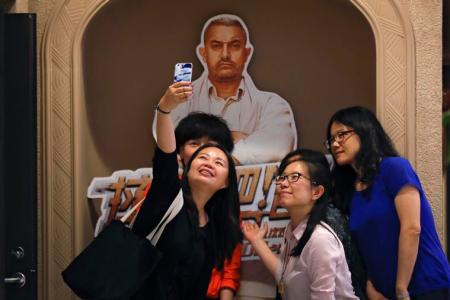 Hitting the right note: From a show of Pandit Ravi Shankar’s grand swan song, Sukanya, his only opera. (photo: Bill Cooper)
Hitting the right note: From a show of Pandit Ravi Shankar’s grand swan song, Sukanya, his only opera. (photo: Bill Cooper)
Just days before he passed away in December 2012, Pandit Ravi Shankar called upon his longtime friend and collaborator David Murphy — a Welsh conductor and a protégé of famed Australian conductor Sir Charles Mackerras — and told him about his vision for an opera. Shankar’s daughter, sitarist Anoushka, had laughed at the idea when she had first heard of it in 2010, saying that merging Indian sounds with operatic tones would sound “strange”. “But Shankar was very clear about what he wanted to be known as his final piece,” says Murphy in a telephone conversation from London. In the next few days, Murphy found himself at Scripps Memorial Hospital in San Diego, US, almost everyday, sitting by Shankar’s bedside, discussing and writing his music in western notation. Shankar’s swan song, Sukanya, his only opera, premiered at Curve Theatre in Leicester, UK, last month. It went on to be staged at Symphony Hall, Birmingham, and later, at the prestigious Royal Festival Hall in London.
“Our meetings in the hospital were quite interesting. The incredible thing was that he was so fragile, but the moment we began to talk about music and the opera, his eyes would brighten up. He’d talk of ragas, the notes and how he wanted to leave this project as an ode to his wife, Sukanya. Seeing him work like that was a phenomenal experience,” says Murphy, who first met Shankar in 2004.
Sukanya is a tale from the Mahabharata in which a young princess accidentally blinds an old sage Chyavana and later falls in love with him. She remains loyal to him despite two young and handsome demigods trying to woo her. Sukanya Shankar’s mother had narrated the story to Pt Ravi Shankar in the mid ’90s.
He was fascinated by it and had wanted to create an opera out of it. “My memory is very vivid of the day he asked my mother about the story behind my name and wanted to begin work on an opera on it. With his busy schedule, it was shelved,” says Sukanya Shankar in her press statement. While Shankar completed most of the piece, Murphy and Anoushka, began working together after his death and have brought it to its current form. Shankar’s vision, says Murphy, came with such clarity that it was a great motivation. “I’d been working with him on so many projects. It was a big jump for an Indian musician to write an opera but it felt like a natural progression,” says Murphy.
The premiere saw 60 musicians from London Philharmonic Orchestra (LPO) play alongside Hindustani classical musicians on shehnai, tabla, mridangam and the sitar, while soprano Susanna Hurrell — in the eponymous role — led the operatic voices. This is merged with kannakol — the percussion taalas which are recited as fast-paced bols. The libretto (written text) for the piece has been written by author Amit Chaudhari and draws not only from the Sanskrit texts of the Mahabharata but also from the prose and verse of Rabindranath Tagore, TS Elliot and Shakespeare. The production has been turned into quite a spectacle by director Suba Das, who has used projections on the screen, elaborate costumes and added frantic twirls of Kathak dancers trained by choreographer Aakash Odedra and combined it all with the actors narrating the story.
For Das, who was roped in almost three years ago, this was his first experience of opera. Growing up in a Bengali home in Newcastle, Das had heard Ravi Shankar’s LPs since childhood. “I’m deeply honoured, slightly overwhelmed and a bit terrified. The piece also has a kind of rigorous literary quality. I studied literature at Cambridge so I can spot these writings and contexts from three miles away. There were a lot of different elements to work with,” says 32-year-old Das, who trained as a director at Birkbeck, University of London.
Murphy says every note from every raga that has been used in the production draws from Shankar’s life in some way. Sukanya opens with a prelude in the melancholic raag Bairagi, which soon goes into the overture that the orchestra plays as the sage enters the stage. Shankar also found himself drawn to the vocal style of a taraana, Amir Khusrau’s invention.This piece is rendered by the soprano, sung when Sukanya meanders into the forest and blinds him.
Hurrell uses the opera tone and aesthetic but her melody is based on Hindustani classical ragas. Sukanya is then given in marriage to the sage, who teaches her music. This extended scene is in raag Yaman Kalyan. This is special because this was the raag Shankar was playing on the sitar the day Sukanya Shankar (then Rajan) fell in love with him.
“The challenge was to make it all flow and look spectacular,” says Das. To ensure that, he has drawn from the aesthetics of pop gigs. “When you watch a production now, you aren’t just looking at how musically sound it is, it is also supposed to look fantastic,” says Das.
During their long association, Murphy and Shankar often discussed the direction western music had taken in the latter half of the 20th century. “He was very aware of the way western music had changed over time and the role Indian music had played in its development. For western composers, Raviji’s music was a great inspiration to find new directions,” says Murphy.
On the evening of November 4, 2012, a month before his death, when a feeble Shankar, wearing an oxygen tube, played at what was to be his last concert in Long Beach, California, with daughter Anoushka, he chose to regale those present with Maru Bihag. After touching each swara with tenderness and ending with a tihaai, he waved at those present — who were applauding the legend tirelessly — did a pranaam and burst into tears. It was as if he was seeing them for one last time and he knew it. Back in the hospital, he was hurrying through the opera, to complete it in time. “So much so, that, sometimes, there was this uncanny feeling, when I conducted, of him guiding the process of creation in the last few years. It felt surreal. It’s a beautiful posthumous gift not only to his wife but also to the world,” says Murphy.

